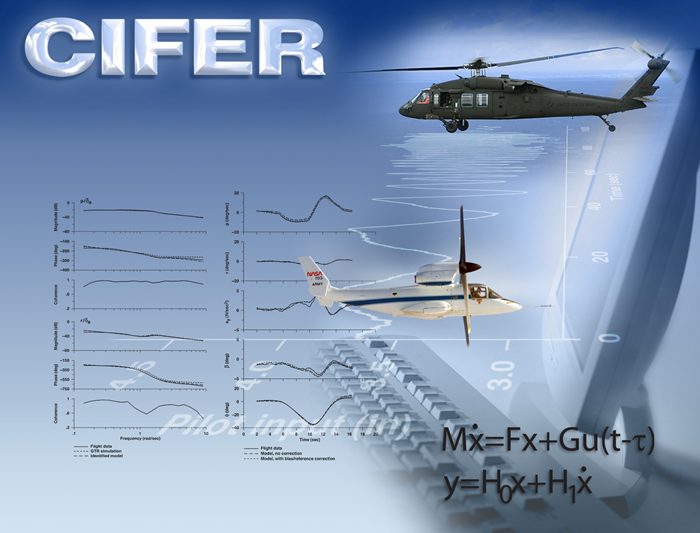CIFER®
Comprehensive Identification from FrEquency Responses

Figure: Comprehensive Identification from FrEquency Responses
System identification is a procedure by which a mathematical description of vehicle
or component dynamic behavior is extracted from test data. System identification can
be thought of as an inverse of simulation. Simulation requires the adoption of (a-priori)
engineering assumptions to allow the formulation of model equations. These simulation
models are then used to predict aircraft or subsystem motion. In contrast, system
identification begins with measured aircraft motion and "inverts" the responses to
rapidly extract a model which accurately reflects the measured aircraft motion, without
making a-priori assumptions or requiring a time-consuming modeling effort. Applications
of system identification results include:
(1) comparison of wind tunnel and flight characteristics; (2) validation and update
of simulation models; (3) handling-qualities analyses and specification compliance;
(4) optimization of automatic flight control systems; and (5) vibration and aeroelastic
analyses.
The U.S. Army Combat Capabilities Development Command (DEVCOM) Aviation & Missile Center (AvMC) and San José State University Research Foundation (SJSURF) jointly distribute an integrated facility for system identification based on a comprehensive frequency-response approach that is uniquely suited to the difficult problems associated with flight-test data analysis. The foundation of the CIFER® approach is the high-quality extraction of a complete multi-input/multi-output (MIMO) set of non-parametric input-to-output frequency responses. These responses fully characterize the coupled characteristics of the system without a-priori assumptions. Advanced Chirp-Z transform and composite optimal window techniques developed and exercised with over 10 years of flight project applications provide significant improvement in frequency-response quality relative to standard Fast Fourier Transforms (FFTs). Sophisticated nonlinear search algorithms are used to extract a state-space model which matches the complete input/output frequency-response data set.
Key Features of the CIFER® Approach Are:
- Identification algorithms highly-exercised and tuned based on many
flight projects - Highly-flexible and interactive definition of identification model structures
- Fully automated weighting function selection based on frequency-response accuracy
- Reliable parameter accuracy metrics
- Integrated procedure for identification and model structure determination
- Time-domain verification of models, including identification of offsets
and biases
Application Modules within CIFER® Allow:
- Rapid identification of transfer-function models
- Spectral signal analysis
- Handling-qualities and classical servoloop analysis
- Time- and frequency-domain comparisons of identification versus simulation model prediction
Additional Information
SALES & OTHER INQUIRIES CONTACT
San José State University Research Foundation
flight-control-sta@sjsu.edu